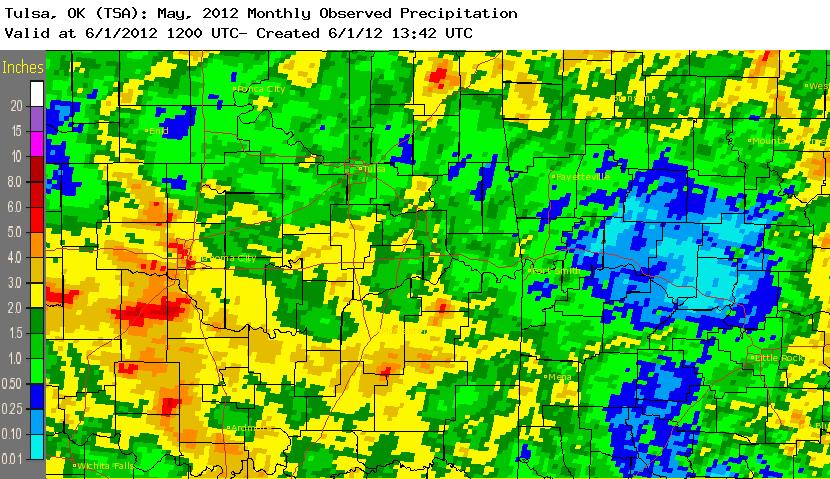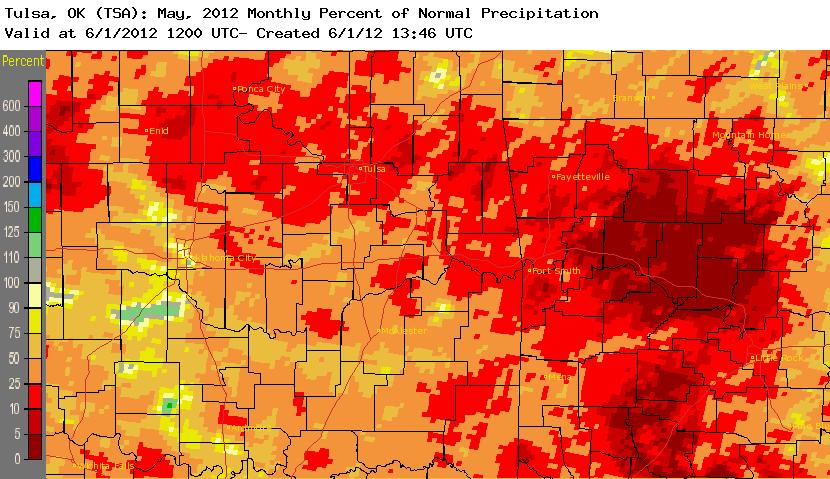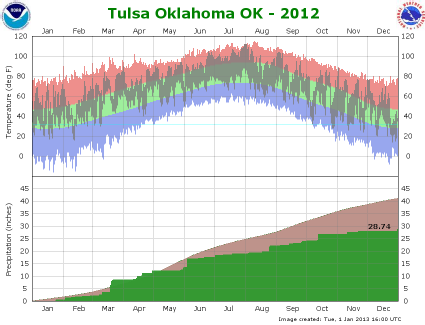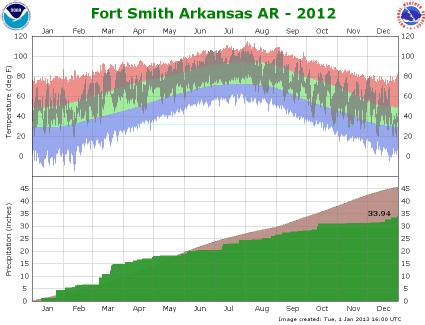Record Warm May and Spring 2012 and very dry May 2012
MAY 2012
Tulsa, OK: 4th driest, 2nd warmest May on record
Fort Smith, AR: 3rd driest, tied for warmest May on record
Fayetteville, AR: driest May on record
SPRING 2012
Tulsa, OK: warmest Spring on record
Fort Smith, AR: warmest Spring on record
Fayetteville, AR: 3rd driest Spring on record
May 2012 was very dry across eastern Oklahoma and northwest Arkansas. Tulsa was in the running to have its driest May on record until a thunderstorm complex brought additional rain during the early morning hours of the 31st. May 2012 ended up as the 4th driest on record in Tulsa. Ft. Smith ended this May as the 3rd driest May on record. Fayetteville had its driest May on record. For May 2012, Ft. Smith tied as the warmest May on record, while Tulsa had its 2nd warmest May. The lack of rain is primarily due to fewer storm systems moving across the Southern Plains than typically occurs during May. May is normally the wettest month of the year across eastern Oklahoma and northwest Arkansas.
Warmer than normal temperatures have persisted through the entire Spring this year (March, April, May), and both Tulsa and Fort Smith recorded the warmest Spring on record. In fact, Spring 2012 smashed the previous record by several degrees! Due to high rainfall totals in March 2012, Spring 2012 ended near to a little below normal at Tulsa and Ft. Smith. Despite the low precipitation totals in May, Spring 2012 will not fall into the top 10 driest Springs on record at either Tulsa or Fort Smith. However, Fayetteville has only received a little over half of the normal Spring rainfall and ended up as the 3rd driest Springs on record. So, does having the warmest Spring on record mean the summer will be really hot too? Scroll to the bottom of the page for more information!
Impacts: Extended periods of warm and windy conditions cause an increase in evapotranspiration, which can then lead to drought conditions if storm systems do not bring replenishing rains. Hopefully the weather pattern will change and bring additional precipitation to the region before the summer heat sets in.
Rainfall Statistics for May and Spring
|
Tulsa rainfall total May 2012:
1.18"
|
| Normal Tulsa May Rainfall: 5.87" |
| Top 10 Driest Mays (records began in 1888) |
| 1 |
1897 |
0.80" |
| 2 |
1924 |
1.06" |
| 3 |
1988 |
1.17" |
| 4 |
2012 |
1.18" |
| 5 |
1945 |
1.33" |
| 6 |
2005 |
1.61" |
| 7 |
1906 |
1.62" |
| 8 |
1997 |
1.66" |
| 9 |
1932 |
1.68" |
| 10 |
1962, 1921 |
1.69" |
|
|
Ft. Smith rainfall total through May 2012:
1.15"
|
| Normal Ft. Smith May Rainfall: 5.47" |
| Top 10 Driest Mays (records began in 1883) |
| 1 |
1886 |
0.38" |
| 2 |
1970 |
0.79" |
| 3 |
2012 |
1.15" |
| 4 |
1921 |
1.18" |
| 5 |
1988 |
1.26" |
| 6 |
1962 |
1.37" |
| 7 |
1925 |
1.44" |
| 8 |
1911 |
1.56" |
| 9 |
1951 |
1.58" |
| 10 |
1997 |
1.62" |
|
|
Fayetteville rainfall total through May 2012:
1.05"
|
| Normal Fayetteville May Rainfall: 5.91" |
| Top 10 Driest Mays (records began in 1950) |
| 1 |
2012 |
1.05" |
| 2 |
1977 |
1.24" |
| 3 |
1988 |
1.65" |
| 4 |
2004 |
2.25" |
| 5 |
1951 |
2.28" |
| 6 |
1962 |
2.31" |
| 7 |
1970 |
2.55" |
| 8 |
1969 |
2.78" |
| 9 |
2008 |
3.24" |
| 10 |
2005 |
3.33" |
|
| Official rainfall is measured at Tulsa International Airport |
Official rainfall is measured at Ft. Smith Regional Airport |
Official rainfall is measured at Fayetteville Drake Field Airport |
| Tulsa Spring (Mar-Apr-May) 2012 rainfall total: 11.04" |
| Normal Tulsa Spring Rainfall: 12.95" |
| Top 10 Driest Springs (records began in 1888) |
| 1 |
1932 |
4.29" |
| 2 |
1911 |
5.31" |
| 3 |
1934 |
5.53" |
| 4 |
1996 |
5.61" |
| 5 |
1936 |
5.61" |
| 6 |
2005 |
5.63" |
| 7 |
1951 |
6.08" |
| 8 |
1969 |
6.79" |
| 9 |
1904 |
6.92" |
| 10 |
1901 |
7.22" |
|
| Ft. Smith Spring (Mar-Apr-May) 2012 rainfall total: 12.20" |
| Normal Ft. Smith Spring Rainfall: 13.62" |
| Top 10 Driest Springs (records began in 1883) |
| 1 |
1936 |
3.44" |
| 2 |
1951 |
6.11" |
| 3 |
1972 |
6.23" |
| 4 |
1962 |
6.29" |
| 5 |
1917 |
6.69" |
| 6 |
1932 |
7.07" |
| 7 |
1925 |
7.30" |
| 8 |
1941 |
7.33" |
| 9 |
1926 |
7.52" |
| 10 |
1969 |
7.66" |
|
| Fayetteville Spring (Mar-Apr-May) 2012 rainfall total: 7.90" |
| Normal Fayetteville Spring Rainfall: 14.53" |
| Top 10 Driest Springs (records began in 1950) |
| 1 |
1963 |
7.59" |
| 2 |
1951 |
7.80" |
| 3 |
2012 |
7.90" |
| 4 |
2007 |
8.27" |
| 5 |
2005 |
8.88" |
| 6 |
1977 |
9.05" |
| 7 |
1962 |
9.29" |
| 8 |
2001 |
9.40" |
| 9 |
1971 |
10.11" |
| 10 |
1965 |
11.11" |
|
 |
 |
| May Rainfall Total |
May Rainall Percent of Normal |
Temperature Statistics for May and Spring
|
Tulsa average temperature May 2012:
74.3°
|
| Normal Tulsa May Temperature: 69.3°F |
| Top 10 Warmest Mays (records began in 1905) |
| 1 |
1962 |
75.3° |
| 2 |
2012 |
74.3° |
| 3 |
1987 |
74.1° |
| 4 |
1991 |
73.7° |
| 5 |
1936 |
73.1° |
| 6 |
1998 |
72.9° |
| 7 |
1996 |
72.9° |
| 8 |
1982 |
72.9° |
| 9 |
1956 |
72.9° |
| 10 |
1977, 1965 |
72.6° |
|
|
Ft. Smith average temperature May 2012:
75.8°
|
| Normal Ft. Smith May Temperature: 69.9°F |
| Top 10 Warmest Mays (records began in 1883) |
| 1 |
2012 |
75.8° |
| 1 |
1962 |
75.8° |
| 3 |
1987 |
74.1° |
| 4 |
1896 |
74.0° |
| 5 |
1956 |
73.8° |
| 6 |
1902 |
73.7° |
| 7 |
1899 |
73.7° |
| 8 |
1998 |
73.5° |
| 9 |
1941 |
73.5° |
| 10 |
1991 |
73.4° |
|
| Official temperature is measured at Tulsa International Airport |
Official temperature is measured at Ft. Smith Regional Airport |
| Tulsa Spring (Mar-Apr-May) 2012 Average Temperature: 67.2° |
| Normal Tulsa Spring Temperature: 60.4°F |
| Top 10 Warmest Springs (records began in 1905) |
| 1 |
2012 |
67.2° |
| 2 |
1936 |
64.9° |
| 3 |
1925 |
64.6° |
| 4 |
2006 |
64.2° |
| 5 |
1991 |
64.2° |
| 6 |
1977 |
64.0° |
| 7 |
1963 |
63.7° |
| 8 |
1938 |
63.2° |
| 9 |
1921 |
63.2° |
| 10 |
2007 |
63.1° |
|
| Ft. Smith Spring (Mar-Apr-May) 2012 Average Temperature: 69.0° |
| Normal Ft. Smith Spring Temperature: 61.4°F |
| Top 10 Warmest Springs (records began in 1883) |
| 1 |
2012 |
69.0° |
| 2 |
2006 |
64.7° |
| 3 |
1938 |
64.6° |
| 4 |
1921 |
64.2° |
| 5 |
1925 |
64.1° |
| 6 |
2004 |
63.9° |
| 7 |
1991 |
63.9° |
| 8 |
1936 |
63.9° |
| 9 |
1967 |
63.8° |
| 10 |
1908 |
63.8° |
|
Normals reference the 1981-2010 normal period.
| Does a really hot Spring mean Summer will be hot too? |
| Tulsa, Oklahoma (107 years) |
| 10 Warmest Springs |
Following Summer
Rank Days 100°F+
|
| 1) 1936 |
3rd Hottest 65 |
| 2) 1925 |
6th Hottest 47 |
| 3) 2006 |
17th Hottest 23 |
| 4) 1991 |
22nd Hottest 11 |
| 5) 1977 |
24th Hottest 8 |
| 6) 1963 |
14th Hottest 20 |
| 7) 1938 |
37th Coolest 0 |
| 8) 1921 |
45th Hottest 15 |
| 9) 2007 |
50th Hottest 6 |
| 10) 1974 |
22nd Coolest 6 |
|
| Fort Smith, AR (130 years) |
| 10 Warmest Springs |
Following Summer
Rank Days 100°F+
|
| 1) 2006 |
20th Hottest 23 |
| 2) 1938 |
17th Hottest 7 |
| 3) 1921 |
42nd Hottest 3 |
| 4) 1925 |
19th Hottest 14 |
| 5) 1936 |
3rd Hottest 46 |
| 6) 1991 |
65th Hottest 3 |
| 7) 2004 |
9th Coolest 0 |
| 8) 1967 |
14th Coolest 0 |
| 9) 1908 |
24th Coolest 0 |
| 10) 1918 |
10th Hottest 18 |
|
Updated: June 1, 2012



